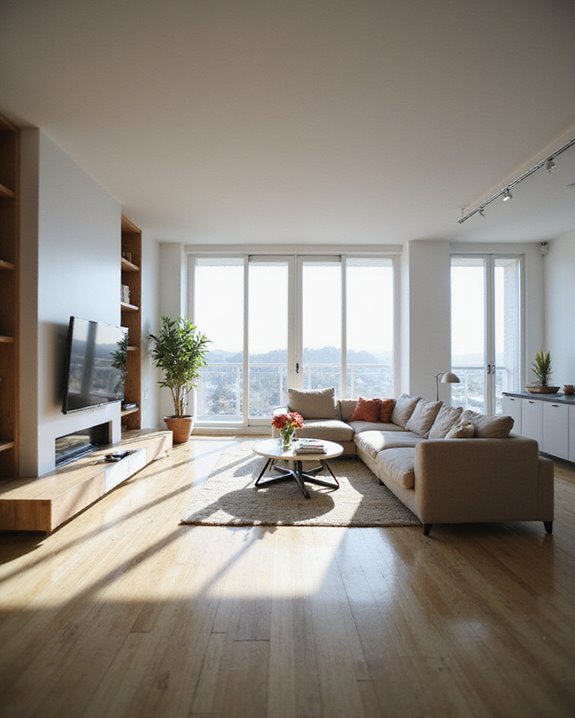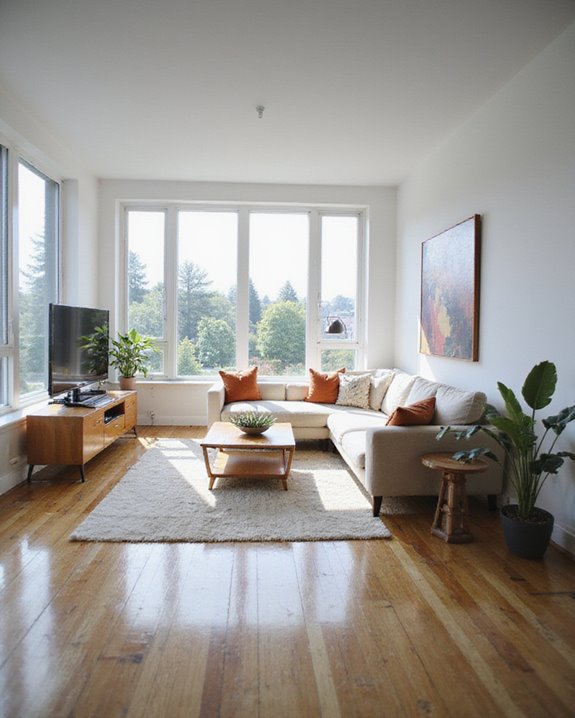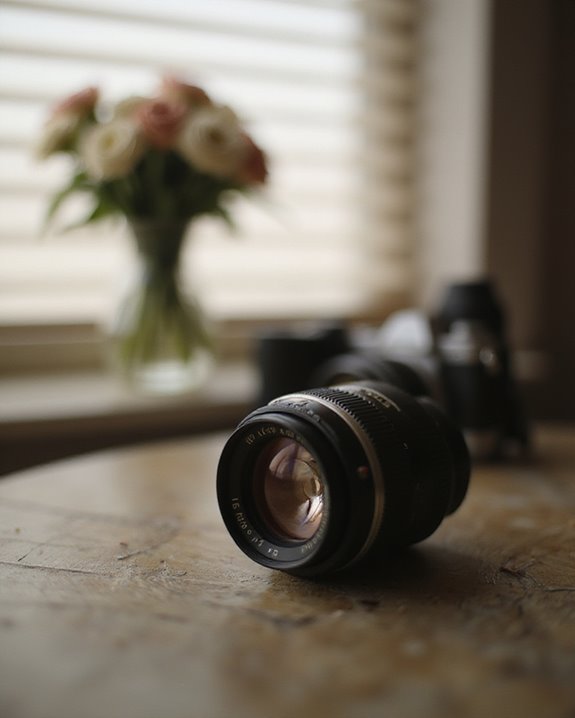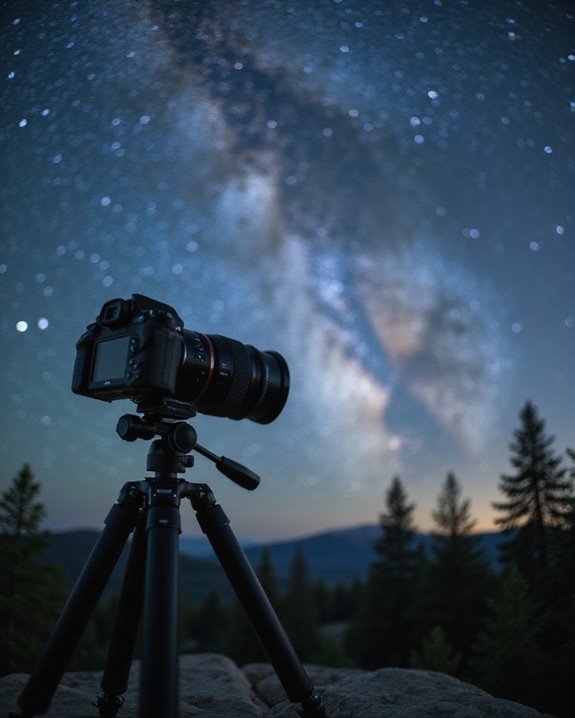Wide-angle lenses with focal lengths ranging from 16mm to 35mm on full-frame sensors are ideal for real estate photography, providing expansive coverage of interior spaces with manageable distortion. Models like the Canon EF 16-35mm f/4L IS USM and Nikon 16-35mm f/4 offer consistent f/4 apertures, image stabilization, and sharpness peaking at f/8, minimizing barrel distortion and vignetting. Alternatives such as Sony’s 12-24mm F/4 G deliver ultra-wide views but require distortion correction. Detailed evaluations of focal length, stabilization, and distortion control inform ideal lens selection for precise architectural imaging. Further technical insights are available.
Key Takeaways
- Wide-angle lenses between 16mm and 35mm on full-frame cameras capture entire rooms with minimal distortion, ideal for real estate photography.
- Lenses with apertures around f/2.8 to f/4 provide sharp edge-to-edge detail and better depth of field control indoors.
- Image stabilization and high build quality enhance handheld shooting in low light and frequent use scenarios.
- Tilt-shift lenses like Canon TS-E 24mm reduce distortion and parallax, improving architectural precision and image fidelity.
- Post-processing distortion correction complements lenses with advanced distortion control to produce natural, buyer-attracting images.
Understanding Wide-Angle Lenses for Real Estate Photography
Wide-angle lenses, defined by focal lengths shorter than 35mm on full-frame camera systems, exhibit a capacity to capture expansive fields of view that encompass entire interior spaces within a single frame, thereby facilitating thorough real estate imagery. These lenses, typically ranging from 16mm to 35mm focal length, provide a wider field of view than standard lenses, essential for framing complete rooms. In real estate photography, wide-angle lenses enhance the depth of field, maintaining sharp focus from foreground to background, which is critical for detailed property representation. However, these lenses can introduce barrel distortion, particularly if the camera is not precisely leveled. Consequently, shooting on a tripod is recommended to stabilize the camera and reduce distortion. Overall, wide-angle lenses remain the preferred lens for real estate due to their spatial exaggeration and extensive scene coverage on full-frame cameras. Additionally, understanding lens distortion and how to minimize it can significantly improve image quality.
Key Factors in Choosing Real Estate Photography Lenses

What criteria determine the best lens selection for real estate photography? Primarily, a wide-angle lens with a focal range between 16mm and 24mm is essential to capture entire rooms while minimizing distortion. Build quality influences durability and handling, with robust constructions preferred for frequent use. Image stabilization enhances sharpness throughout handheld shots, especially in low-light conditions. Image quality is critical; lenses supporting full-frame sensors and apertures around f/2.8, such as zoom lenses spanning 16-35mm, deliver superior edge-to-edge sharpness and detail resolution. Aperture settings from f/2.8 to f/4 balance depth of field and light intake, crucial for indoor environments. Distortion control capabilities guarantee realistic spatial representation, reducing post-processing needs. Advanced ultra-wide lenses with distortion correction features help achieve more natural images with minimal editing. Additional features like filter support and lens hoods contribute to versatility. Collectively, these factors define ideal lens performance for professional real estate photography.
Canon EF 16-35MM F/4l IS USM Lens Overview

The Canon EF 16-35mm f/4L IS USM lens represents a professional-grade optical instrument designed to meet the demands of real estate photography by integrating a versatile focal length range with advanced stabilization and durable construction. This full-frame zoom lens offers a wide 16-35mm focal range, ideal for real estate interiors, enabling expansive room coverage with minimal distortion. Its image stabilization (IS) system effectively reduces camera shake, enhancing handheld shooting performance in low-light conditions common in property environments. The Canon EF lens features robust weather-sealing and a lightweight design at approximately 615 grams, facilitating portability during on-site shoots. Priced near $999, it delivers sharp images, particularly at the 24mm focal point, although minor post-processing may be required to correct slight focus and sharpness inconsistencies. Additionally, the lens’s optical quality benefits from advanced elements that minimize distortion and vignetting, ensuring high-quality images across the frame. Overall, this lens is well-suited for real estate photographers seeking reliable wide-angle versatility.
Nikon Nikkor 16-35MM F/4 Lens Features

Nikon’s Nikkor 16-35mm f/4 lens demonstrates a high level of optical engineering tailored for full-frame Nikon DSLR cameras, producing sharp images with fine detail resolution that are critical for real estate interior photography. This camera lens features a Nano-crystal coating that minimizes internal reflections, effectively reducing ghosting and flare across its 16-35mm zoom range, enhancing image contrast under varied lighting. Though categorized as an expensive lens at $719.95, it balances cost with professional-grade performance, making it an ideal choice among lenses for real estate. Real estate photographers benefit from the consistent f/4 aperture, which guarantees reliable exposure and depth of field control. Overall, the Nikon Nikkor 16-35mm f/4 stands out as the right lens for real estate, delivering versatility and optical precision essential for capturing wide-angle architectural shots.
Sony 12-24MM F/4 G and Zeiss 16-35MM F/4 Lens Comparisons

Among ultra-wide-angle lenses suited for real estate photography, the Sony 12-24mm F/4 G and Zeiss 16-35mm F/4 represent two distinct approaches to balancing focal range, optical performance, and practical usability. The Sony 12-24mm F/4 G offers an ultra-wide 12mm focal length, wide enough for expansive real estate shooting but introduces noticeable distortion, reducing its appeal as a favorite lens for professional real estate work. Its bulbous front element precludes filter use, limiting outdoor versatility. Conversely, the Zeiss 16-35mm F/4 excels in corner sharpness at f/8, features Optical SteadyShot stabilization, and exhibits superior distortion control, making it a preferred choice for real estate. Additionally, the Zeiss is smaller and lighter, enhancing mobility during shoots. Despite the Sony’s wider coverage, the Zeiss is often regarded as the more practical choice for real estate applications.
Third-Party Lens Options: Tamron and Others

Third-party lenses, including models from Tamron, Rokinon/Samyang, Tokina, and Sigma, provide viable alternatives to proprietary brand lenses for real estate photography, balancing cost-efficiency with optical performance. The Tamron 17-28mm f/2.8, priced at $899, is a good option for real estate photographers seeking sharpness wide open from f/2.8 to f/4; its compact size and reversed zoom/focus rings distinguish it within the range. Rokinon/Samyang’s 14mm f/2.8 offers less expensive wide-angle coverage but lacks autofocus, requiring manual focus and distortion correction. Tokina’s 11-16mm f/2.8 DX II is ideal for APS-C sensors, providing a constant aperture with minor vignetting at 16mm. Sigma’s 18-35mm f/1.8 ART delivers slightly sharper images and excellent color rendition for APS-C formats, though vignetting may occur. Choosing the right third-party lens allows real estate photographers to optimize wide-angle interior captures cost-effectively.
Expert Recommendations From Real Estate Photographers

Expert real estate photographers frequently endorse Canon lenses, attributing their preference to a combination of optical precision, focal versatility, and specialized functionalities such as tilt-shift mechanisms. Travis Mark’s recommendation of the Canon 24mm tilt-shift lens highlights its sharpness and wide field, enabling interior shots that capture stunning real estate nuances while avoiding distracting elements. Tim Krueger’s shooting mostly with Canon’s 17-40mm F4L emphasizes its focal range and consistent sharpness, making it a go-to lens for diverse residential and exterior shots. John Muggenborg and Mindie Ballard similarly prioritize one of Canon’s wide field lenses—the TS-E 24mm f/3.5L II and the 16-35mm f/4 respectively—for architectural precision and room-wide coverage. Michael Lefebvre values the EF 16-35mm f/4L for its sharpness near 24mm and cost-effectiveness, underscoring its frequent use in stunning real estate photography.
Managing Distortion and Enhancing Image Quality

Wide-angle lenses play a critical role in managing distortion and enhancing image quality in real estate photography, with models such as the Sony 16-35mm F/2.8 GM demonstrating superior control over barrel and pincushion distortions, particularly when stopped down to f/8, where sharpness across the frame—including corners—remains consistently high. The Canon 16-35mm f/4 lens also performs well in capturing entire rooms without unrealistic perspective exaggeration, making it ideal for diverse interior spaces. Tilt-shift models like the Canon TS-E 24mm f/3.5L II reduce parallax error by shifting the lens, avoiding distracting elements, thereby enhancing image fidelity. Post-processing, utilizing distortion correction algorithms, complements built-in lens performance, addressing up to 95% of typical distortions. Whether you’re a seasoned professional or getting started, managing shutter speed and lens selection does the heavy lifting to produce images that attract potential buyers, always shooting with precision and clarity.
Frequently Asked Questions
What Lens Is Best for Real Estate Photos?
Which lens balances sharpness and versatility for real estate photos? Experts suggest budget options like Canon’s 17-40mm F4L, emphasizing lens cleaning, maintenance tips, user feedback, brand comparisons, storage solutions, accessory pairing, image editing, and ethical choices.
How Wide of a Lens Do You Need for Real Estate Photography?
The ideal lens width balances lens distortion and perspective control, typically 16-24mm. Angle comparison aids interior framing and exterior capture, while composition strategies, lighting impact, stabilization methods, and post processing enhance final images effectively.
What Camera Lens Do Estate Agents Use?
Like bees drawn to blossoms, estate agents prefer lenses balancing Agent Preferences and Budget Options. They favor Portable Gear and Smartphone Lenses for flexibility, consider Lens Maintenance, Accessory Choices, and rely on Client Feedback and Trend Updates as essential Marketing Tools.
What Camera Do Most Real Estate Photographers Use?
Most real estate photographers prefer camera brands like Canon, Nikon, and Sony, favoring full-frame sensor technology for high resolution specs, reliable autofocus systems, efficient battery life, image stabilization, versatile shutter speed, compatible memory cards, and flexible file formats.
What Focal Length Is Good for Real Estate?
The ideal focal length balances angle choice and focal depth to minimize space distortion, ensuring perspective control and high image quality. Real estate zooms between 16mm and 24mm optimize property framing for both indoor focal and outdoor length scenarios.





